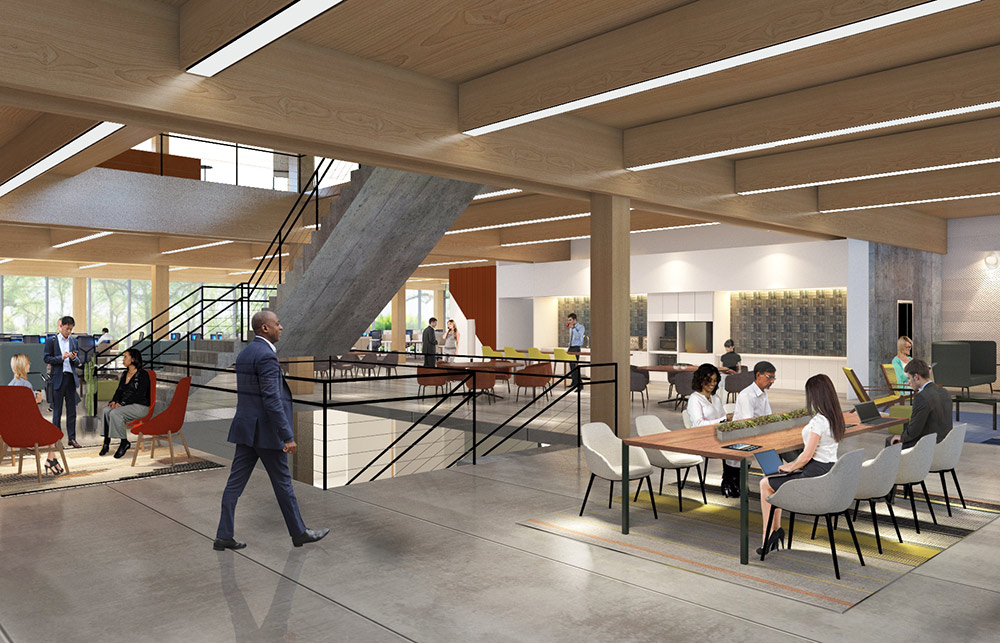
随着疫情消退,许多科技公司的首席执行官都将居家办公视为新的工作方式。但沃尔玛的首席执行官却表示,当一切恢复正常时,员工面对面的工作时间仍然至关重要,这将有助于他们更好地展开协作。
去年,沃尔玛公布了其在本顿维尔的新总部的计划。该总部占地350英亩,由过时的办公设施改造而成,新园区的建设由工人分阶段进行,预计2025年完工。沃尔玛希望以此吸引和留住人才,并与亚马逊、谷歌和苹果等公司展开竞争。
不过由于新冠疫情的爆发,让人们不得不连续几个月居家办公。尽管如此,沃尔玛的首席执行官董明伦依然坚信,同事之间线下合作的价值将一直存在,并表示这不会给未来新总部的设计带来太大改变。
董明伦在本周三举行的沃尔玛年度股东大会上表示,“你是怎样与他人结识的?你要如何感受到团体文化?公司文化是一个非常重要的方面。”
未来的沃尔玛总部将具有现代办公生活的特点,包括大量的木质建筑、宽敞的自行车道、绿地以及户外会议室。沃尔玛的定位是一家尖端的高科技公司,致力于吸引能力最强的技术和零售人才。
沃尔玛是美国员工最多的私营雇主,在美国拥有140万名员工。由于创始人山姆·沃尔顿厌恶奢华的风格,所以目前的园区由20栋不起眼的建筑组成,许多建筑只有一层。新园区将由办公室和咖啡厅组成,其中含有智能建筑设计、太阳能电池板和区域采购材料。
尽管如此,新冠疫情的爆发还是让无数公司重新思考,他们是否真的需要员工来办公室工作。Shopify的首席执行官托比·吕特克对《财富》杂志表示,从现在起,这家加拿大电子商务公司的大部分员工将居家办公。
吕特克说:“至少在科技行业,我们将不会回到以办公室工作为重的状态。”推特和Square也为员工提供了永久居家办公的选择,Facebook的首席执行官马克·扎克伯格表示,他预计在未来5到10年间,该公司50%的员工将远程工作。
沃尔玛的公司事务团队执行副总裁丹·巴特利特指出,新办公室项目仍在设计阶段,因此还可以做出改变,不会“打乱项目的整体时间规划”。
如今,沃尔玛已经成为仅次于亚马逊的第二大零售商。沃尔玛各部门之间的合作共赢,这在零售业与电子商务领域的竞争中是一个至关重要的优势。
“在接种疫苗后,我们将需要办公空间,人们也需要合作。”董明伦说,“随着时间的推移,彼此在场是很重要的。”
编译:于佳鑫
随着疫情消退,许多科技公司的首席执行官都将居家办公视为新的工作方式。但沃尔玛的首席执行官却表示,当一切恢复正常时,员工面对面的工作时间仍然至关重要,这将有助于他们更好地展开协作。
去年,沃尔玛公布了其在本顿维尔的新总部的计划。该总部占地350英亩,由过时的办公设施改造而成,新园区的建设由工人分阶段进行,预计2025年完工。沃尔玛希望以此吸引和留住人才,并与亚马逊、谷歌和苹果等公司展开竞争。
不过由于新冠疫情的爆发,让人们不得不连续几个月居家办公。尽管如此,沃尔玛的首席执行官董明伦依然坚信,同事之间线下合作的价值将一直存在,并表示这不会给未来新总部的设计带来太大改变。
董明伦在本周三举行的沃尔玛年度股东大会上表示,“你是怎样与他人结识的?你要如何感受到团体文化?公司文化是一个非常重要的方面。”
未来的沃尔玛总部将具有现代办公生活的特点,包括大量的木质建筑、宽敞的自行车道、绿地以及户外会议室。沃尔玛的定位是一家尖端的高科技公司,致力于吸引能力最强的技术和零售人才。
沃尔玛是美国员工最多的私营雇主,在美国拥有140万名员工。由于创始人山姆·沃尔顿厌恶奢华的风格,所以目前的园区由20栋不起眼的建筑组成,许多建筑只有一层。新园区将由办公室和咖啡厅组成,其中含有智能建筑设计、太阳能电池板和区域采购材料。
尽管如此,新冠疫情的爆发还是让无数公司重新思考,他们是否真的需要员工来办公室工作。Shopify的首席执行官托比·吕特克对《财富》杂志表示,从现在起,这家加拿大电子商务公司的大部分员工将居家办公。
吕特克说:“至少在科技行业,我们将不会回到以办公室工作为重的状态。”推特和Square也为员工提供了永久居家办公的选择,Facebook的首席执行官马克·扎克伯格表示,他预计在未来5到10年间,该公司50%的员工将远程工作。
沃尔玛的公司事务团队执行副总裁丹·巴特利特指出,新办公室项目仍在设计阶段,因此还可以做出改变,不会“打乱项目的整体时间规划”。
如今,沃尔玛已经成为仅次于亚马逊的第二大零售商。沃尔玛各部门之间的合作共赢,这在零售业与电子商务领域的竞争中是一个至关重要的优势。
“在接种疫苗后,我们将需要办公空间,人们也需要合作。”董明伦说,“随着时间的推移,彼此在场是很重要的。”
编译:于佳鑫
In contrast to the many tech CEOs viewing work-from-home as the new standard well after the pandemic eases, Walmart’s chief executive says face time at the office will remain crucial to how the retailer’s corporate employees function when things get back to normal—and once its new campus opens.
Walmart last year heralded a new 350-acre home office project expected to open in its hometown of Bentonville, Ark., in stages and be completed by 2025, revamping an outdated facility in hopes of more easily attracting and retaining talent for which it has to compete with the likes of Amazon, Google, and Apple.
But the plan was announced well before anyone could imagine a pandemic like COVID-19 would have people working from home for months on end. Yet despite that, Walmart CEO Doug McMillon firmly believes the value of in-person collaboration with colleagues will endure and says it won’t change the future home office’s design much.
“As this crisis has gone on, we’ve noticed things that were missing,” McMillon said on a webcast of Walmart’s annual shareholder meeting on Wednesday. “How do you get to know people? How do you get a sense for what the culture is like? Culture inside a company is such an important aspect.”
The future Walmart headquarters will boast features of modern-day office life including mass timber construction, ample biking paths (the company wants 10% of employees to commute by bike), green space, and outdoor meeting rooms to position itself as a high-tech, cutting-edge company worthy of today’s biggest tech and retail talent, and not just a mammoth discount chain.
Walmart, the largest private U.S. employer with 1.4 million workers, has a staff of about 14,000 at its headquarters. The current campus is made up of a decentralized series of 20 nondescript buildings, many with one floor only in deference to founder Sam Walton’s aversion to flash. The new campus will be made up of offices and cafés with smart building design, solar panels, and regionally sourced materials, surrounded by outdoor spaces.
Still, the pandemic has led countless companies to rethink whether they really need people come into the office as much. Shopify CEO Tobi Lütke recently told Fortune that most of the Canadian e-commerce company’s employees would work from home from now on.
“One thing we’re not going to get back to, at least in the tech industry, is office-centricity,” Lütke said. Twitter and Square have also given employees the option to work from home permanently, while Facebook CEO Mark Zuckerberg thinks half of his employees could be working remotely in five to 10 years.
Walmart’s executive vice president of corporate affairs, Dan Bartlett, said the new office project was still in the design stages, so changes could be made to reflect any longer-lasting impacts of the pandemic and how Americans like to work without “disrupting the overall time frame of the project.”
The company was long afflicted by a silo culture in which different divisions didn’t work together well enough. That was notably the case with its e-commerce and retail divisions for years. But now Walmart has emerged as a strong No. 2 to Amazon, and the retailer is benefiting from more harmony across its divisions, a crucial advantage in the retail and e-commerce wars.
“In a post-vaccine world we’re going to need office space, and people are going to collaborate,” McMillon said. “Being present with each other is going to matter over time.”






